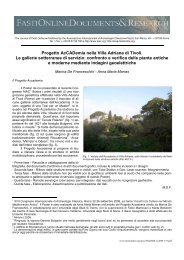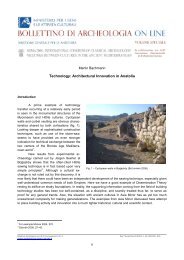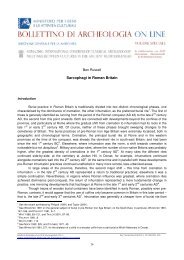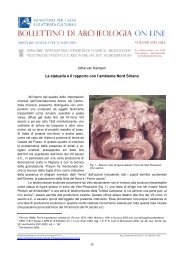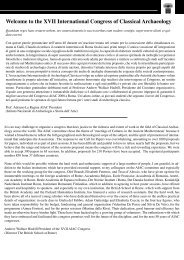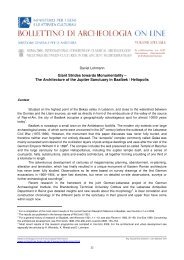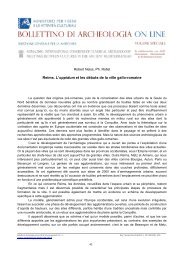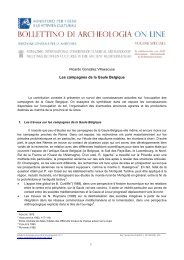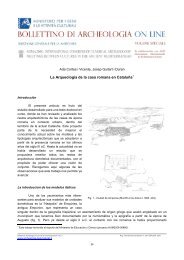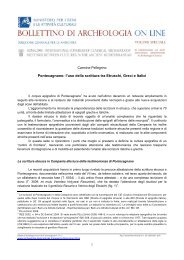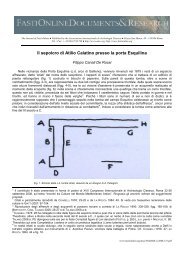La cronologia della tarda età di La Tène e dell'età augustea nella ...
La cronologia della tarda età di La Tène e dell'età augustea nella ...
La cronologia della tarda età di La Tène e dell'età augustea nella ...
You also want an ePaper? Increase the reach of your titles
YUMPU automatically turns print PDFs into web optimized ePapers that Google loves.
P. Piana Agostinetti, R. Knobloch – <strong>La</strong> <strong>cronologia</strong> <strong>della</strong> <strong>tarda</strong> <strong>età</strong> <strong>di</strong> <strong>La</strong> <strong>Tène</strong> e dell’<strong>età</strong> <strong>augustea</strong> <strong>nella</strong> Transpadana centro-occidentale<br />
Fig. 10 - Le fibule e il vasellame ceramico <strong>di</strong> alcuni corre<strong>di</strong> <strong>della</strong> Transpadana centro-occidentale esemplificativi dell’orizzonte delle<br />
fibule a staffa chiusa/traforata.<br />
6. Orizzonte delle fibule a cerniera (fig. 11)<br />
In questa fase si <strong>di</strong>ffondono le fibule “tipo Alesia” e “tipo Aucissa” nelle loro numerose vari<strong>età</strong>. Tra i<br />
tipi <strong>di</strong> fibule a molla <strong>di</strong>ffusi negli orizzonti precedenti si conservano solamente le fibule a staffa chiusa<br />
desinente a bottoncino rialzato mentre scompaiono le fibule “tipo Nauheim“, “Almgen 65” e le<br />
“Schüsselfibeln” 18 . Contemporaneamente si <strong>di</strong>ffonde un tipo <strong>di</strong> fibula <strong>di</strong> ferro <strong>di</strong> struttura molto semplice con<br />
arco rialzato e gomito sopra la staffa. Il vasellame ceramico è costituito dalle ultime forme <strong>della</strong> vernice nera<br />
(coppe <strong>di</strong> forma <strong>La</strong>mboglia 28 e patere <strong>di</strong> gran<strong>di</strong> <strong>di</strong>mensioni <strong>di</strong> forma <strong>La</strong>mboglia 5/7), da coppe e patere in<br />
terra sigillata, da bicchieri a pareti sottili o realizzati a stampo entro matrice (i noti tipo “Aco” e “Sarius”).<br />
<strong>La</strong> fig. 12 riassume la successione degli orizzonti e dei “tipi” <strong>di</strong> fibula scelti come fossili guida con, in<br />
alto, i riferimenti ai principali eventi storici del periodo e, in basso, l’aggancio ad alcuni dei corre<strong>di</strong> illustrati.<br />
(R. K.)<br />
18 Tra le attestazioni più tarde <strong>di</strong> fibule “ tipo Cenisola” si menziona la tomba 31 <strong>di</strong> Oleggio (NO), genericamente ascrivibile alla fine del I<br />
secolo a.C.: SPAGNOLO GARZOLI 1999, 89–91. Alcune forme ceramiche in<strong>di</strong>gene (olle e ollette con decorazione a impressione ad onde,<br />
striature orizzontali o a bugnette) continuano a essere deposte nei contesti tombali fino all’inizio dell’<strong>età</strong> tiberiana<br />
Bollettino <strong>di</strong> Archeologia on line I 2010/ Volume speciale F / F10 / 2 Reg. Tribunale Roma 05.08.2010 n. 330 ISSN 2039 - 0076<br />
www.archeologia.beniculturali.it/pages/pubblicazioni.html<br />
16



